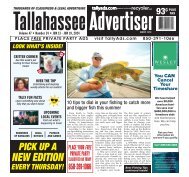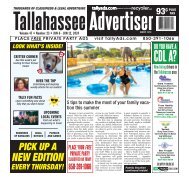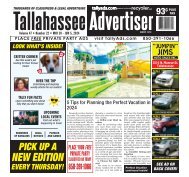070122_TT_AllPages
You also want an ePaper? Increase the reach of your titles
YUMPU automatically turns print PDFs into web optimized ePapers that Google loves.
THETRUCKER.COM PERSPECTIVE<br />
JULY 2022 • 9<br />
Mickey Gilley leads two country music cultural shifts<br />
RHYTHM OF<br />
THE ROAD<br />
KRIS RUTHERFORD<br />
krisr@thetruckermedia.com<br />
By the late 1970s, Mickey Gilley was a bona fide<br />
country music headliner. But he couldn’t have imagined<br />
what lay in store for him as the decade ended,<br />
even as a hint of the success he was about to enjoy<br />
came from a 1977 song by his famous cousin Jerry<br />
Lee Lewis.<br />
The next to the last of Lewis’ string of Top 5 singles<br />
came by way of his No. 4 hit “Middle-Age Crazy.”<br />
The plot of the lyrics revolves around a successful<br />
businessman’s mid-life crisis. Despite his success,<br />
something is missing from his life. To deal with<br />
growing older, he remakes himself. As Lewis sang,<br />
he traded his business suit for “jeans and high boots<br />
with an embroidered star.”<br />
Neither Lewis nor Gilley realized that the minor<br />
hit set the stage for a cultural shift in the U.S. “Middle-Age<br />
Crazy” was released as a movie starring<br />
Bruce Dern in early 1980, but it largely failed at the<br />
box office. However, the motion picture’s theme was<br />
about to become ingrained in American culture.<br />
The “cowboy look” soon became the American<br />
style of the early 1980s — only it wasn’t Lewis who<br />
helped bring cowboy dress to the forefront. Instead,<br />
it was Gilley, with a healthy dose of John Travolta,<br />
who led the revolution.<br />
When producers of the movie “Urban Cowboy”<br />
looked for a location to shoot their film, they knew<br />
they needed a country nightclub, and a big one.<br />
The so-called largest honky-tonk in the U.S., Gilley’s<br />
Club in Pasadena, Texas, offered the perfect backdrop.<br />
John Travolta, who was fresh off starring in<br />
the anything-but-country motion pictures “Grease”<br />
and “Saturday Night Fever,” found himself cast in the<br />
role of country boy Bud Davis, a young man who relocates<br />
to the Houston area and starts frequenting<br />
Gilley’s club.<br />
Looking back over four decades, the plot of “Urban<br />
Cowboy” is easily forgotten. But for those who<br />
lived through the era it ushered in, the movie’s impact<br />
is hard to forget.<br />
Gilley and several nightclub employees had<br />
parts in the movie, and Gilley’s band provided much<br />
of the soundtrack. Gilley himself was featured on the<br />
soundtrack album. “Here Comes the Hurt Again”<br />
brought Gilley a lot of air play — but it was his countryfied<br />
rendition of the soul song “Stand by Me” that<br />
elevated him from being an occasional hit maker to<br />
one of the 1980s most prolific artists.<br />
Likewise, it was Gilley’s style — cowboy boots,<br />
western hats with feathered grommets, and just<br />
a general western style of dress — that became all<br />
the rage. Areas of the country like New England,<br />
where few followed country music and only a handful<br />
of true cowboys lived, were suddenly overrun by<br />
Yankees donning the “Urban Cowboy” style. The period<br />
did much to increase the popularity of country<br />
music nationwide, and western retailers popped up<br />
from coast to coast.<br />
In short order, the image of the “Urban Cowboy”<br />
shifted from John Travolta’s character to the real-life<br />
Gilley. Gilley’s nightclub became a sensation and<br />
spawned the opening of similar country clubs across<br />
the nation. It also created an environment in which<br />
one of country music’s most popular female singers,<br />
Barbara Mandrell, could record her signature song,<br />
“I was Country (When Country wasn’t Cool).”<br />
By the time Gilley’s career slowed down, he had<br />
charted 39 Top 10 singles, 17 of which reached No.<br />
1. The likes of “You Don’t Know Me,” “That’s All that<br />
Matters to Me” and “True Love Ways” became classics<br />
of the 1980s country era. As the decade passed,<br />
Gilley shifted his music to a more orchestrated style,<br />
featuring strings and his iconic piano in his recordings<br />
rather than the hard-driving piano of his earlier<br />
sons like “The Girls All Get Prettier at Closing Time.”<br />
This fresh Gilley style was largely inspired by the<br />
crossover success many country artists experienced<br />
during the decade. The change in his music also reflected<br />
a change in Gilley’s persona. The man who<br />
had ridden a nightclub to fame made himself over<br />
for a new audience. He sold his nightclub and relocated<br />
to a new spot in the U.S. where country music<br />
was taking off — Branson, Missouri.<br />
Branson was a growing community that centered<br />
around country music-related entertainment.<br />
For a performer like Gilley, the area was a godsend.<br />
The city became packed with theaters and boasted<br />
as many current and former stars per square mile<br />
than anywhere other than Nashville. And the town<br />
became a saving grace for more than one artist’s<br />
career.<br />
“Branson works because it provides the best<br />
conditions for the fans and the entertainers,” Gilley<br />
said. “The fans get to see us under the best setting<br />
possible … theaters have good seats, and we have<br />
the best stage setups.”<br />
What’s more, performers in Branson often<br />
owned their theaters. They didn’t have to deal with<br />
the daily grind of putting together and tearing down<br />
a stage show. The grueling pace of touring didn’t<br />
wear down the performers, most of whom owned<br />
homes not far from their theaters. Throughout the<br />
1990s, Branson grew, and Gilley found himself at the<br />
center of another seismic shift on the country music<br />
scene. He became one of Branson’s most popular<br />
stars, raking in profits from hundreds of fans who’d<br />
visit for both afternoon and evening shows held<br />
year-round.<br />
While the new hits stopped coming when Gilley<br />
shifted to Branson, the audiences his show attracted<br />
didn’t seem to care. Promoters marketed Branson<br />
toward an older crowd — people who remembered<br />
the likes of Andy Williams, Floyd Kramer, Mel Tillis<br />
and numerous comedy and variety shows. These<br />
people didn’t expect or want to hear new material<br />
from the performers whose shows they frequented;<br />
they wanted to hear the hit songs of days gone by.<br />
Gilley’s former popularity provided enough hit<br />
songs to fill a show, and recording wasn’t as important<br />
as it had been earlier in his career. Branson became<br />
a prime retirement area for people looking for<br />
a nice place to live, and it served semi-retired performers<br />
as well.<br />
For the most part, Gilley played out his life in<br />
Branson. His shows were among the most popular<br />
in the city. Gilley’s name became as much a part of<br />
Branson as the ever-popular theme park Silver Dollar<br />
City. And it provided an iconic setting for a popular<br />
artist to complete a career that headlined two of<br />
the most noted contributions to late 20th century<br />
country music.<br />
Until next time, don’t wear a cowboy hat in a<br />
Ford Focus. It just ain’t right. 8<br />
Aim your camera<br />
Find the best<br />
truck-driving<br />
jobs<br />
as well news, videos and job<br />
resources ... all in one place!<br />
at the code to<br />
find jobs.

















